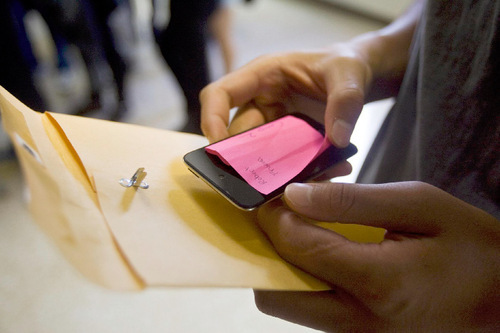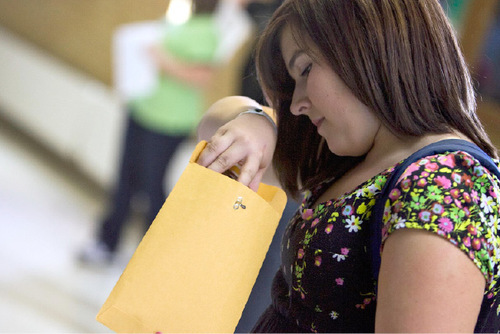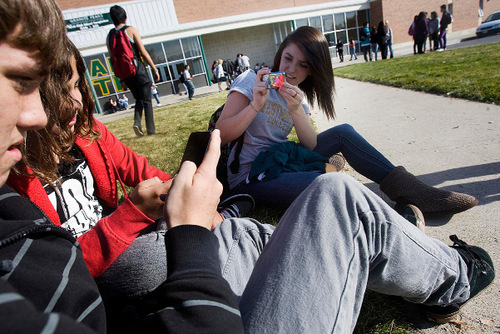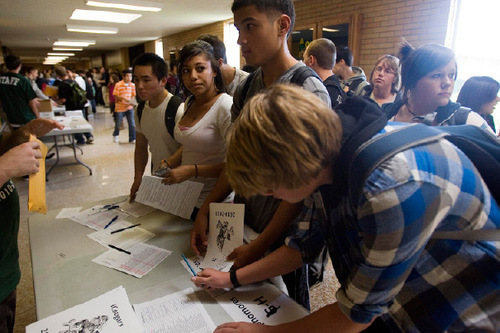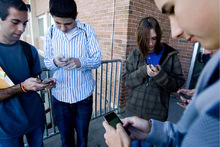This is an archived article that was published on sltrib.com in 2010, and information in the article may be outdated. It is provided only for personal research purposes and may not be reprinted.
Nearly 1,700 students at Kearns High snagged a sleek new tool for their book bags on Friday: an iPod touch. Students at the high school screamed with delight during a kick-off assembly that featured students break dancing to digital beats.
"This is the most exciting day of my life," said Kirsten Leaver, a junior who immediately began tinkering with her new iPod. "It's so futuristic. You don't even have to use books anymore."
Her friend R.J. Hall, a senior, disagreed.
"It's not even futuristic," he said. "It's what everyone should have today."
That's the idea behind Kearns High's push to create 21st-century classrooms. This summer, the school received a $1 million federal stimulus Enhancing Education Through Technology grant. The money purchased iPods and educational applications for every student, and iPads for every teacher.
"It's like having a computer lab in your classroom," said Principal Stephen Hess. "What's exciting about it is how it's going to increase engagement of students and how it changes the practice of teachers. It's going to be less 'set-and-get' style lectures and more student participation."
Each iPod comes equipped with 428 applications. Students can keep track of homework assignments and get automatic reminders of due dates, create and study flash cards, and read text books while highlighting key points and looking up unfamiliar words in the dictionary. They also can study the periodic table for chemistry class, answer complex math equations, compose music and learn the constellations in the night sky. Students in an interior design class will be able to design their dream kitchens electronically, instead of with paper and pencil, and e-mail assignments to their teacher.
The iPod means that students can answer their own questions at any time during class, said English teacher Aimee Duran.
"It levels the playing field," she said. "If I have one kid who's a little bit behind and is afraid of raising his hand when I say a word he doesn't understand, he can pull out the iPod and look it up himself. It really puts the responsibility back in [students'] hands."
The program has earned some criticism. In August, Republican U.S. Sens. John McCain of Arizona and Tom Coburn of Oklahoma, included the Kearns High grant on a list of 100 questionable uses of stimulus funds.
"We're here to prove them wrong," said J.R. Finai, a senior and student body officer at Kearns. "Our school under- stands how important this is. We're confident in this program and we feel very strongly that it will be a huge success."
Teachers received training the past couple months — and some started last year — on how to teach with the iPods. They've also discussed ideas for how to make sure students don't use the devices to goof off during class, Duran said. She plans to ask students to set the iPods face down on their desks when not in use for classroom work.
The school hopes to receive additional grants in the future to keep the iPods in student hands. Students will be asked to turn in their iPods, which retail for $229 each, during summer vacation. But they get to keep them if they graduate.
That, said Leaver, could lead to rising graduation rates.
About Kearns High iPods
Cost • $1 million federal Enhancing Education Through Technology grant.
Quantity • Nearly 1,700 iPod touches. The devices each have eight gigabytes of storage.
Rules • Students must bring iPods to class every day with a full charge. They do not have the ability to add applications, but can download music. Students are required to replace lost, stolen or damaged iPods but can purchase insurance for $25 a year. Graduating seniors get to keep their iPods.




